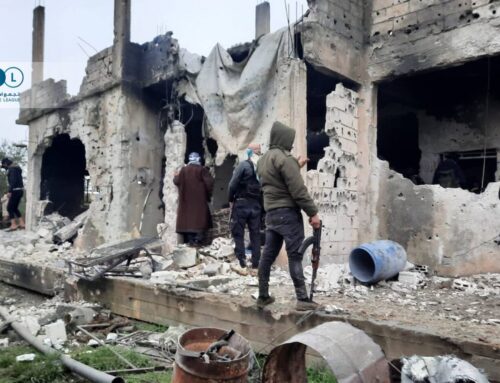Truce moves one step forward in south Damascus neighborhood
Busses transported dozens of families displaced for more than three […]
20 January 2016
Busses transported dozens of families displaced for more than three years back to their southern Damascus neighborhood on Wednesday, a year and a half after the local opposition council reached a truce agreement with the regime.
Fierce fighting between rebel and regime forces have left the neighborhood nearly deserted and destroyed, with more than 90 percent of the approximately 150,000 residents having fled to other areas in or around the capital by late 2012, according to a Facebook post by the Local Council of AlQadam on Wednesday.
Rebels controlling al-Qadam entered into a ceasefire agreement with the regime in August 2014, ending a total regime blockade of the eastern, FSA-held part of the neighborhood, which sits near the Damascus-Amman highway.
Though Syria Direct was unable to confirm whether the families have in fact entered the neighborhood or not, Muhammad Said, a citizen journalist inside rebel-held al-Qadam, confirmed that the first group of displaced residents “had left regime-held Kiswa [Wednesday] morning and arrived at the entry point to al-Qadam.”
The residents returning home had registered with the local council and were cleared by the regime, according to an announcement posted to the Local Council of AlQadam’s Facebook page on Tuesday.
The council will continue to register additional residents wishing to return, Taim a-Shami, a spokesman for the al-Qadam opposition council told Syria Direct Wednesday.
According to the terms of the truce, civilians in rebel-controlled east al-Qadam gained access to the regime-held western section via regime checkpoints. From there, they may leave the town.
While water and electricity are available in the regime-held western section, there is no electricity in the opposition-held east and water only reaches some areas, leaving most reliant on wells, said a-Shami.
This is contrary to other conditions in the ceasefire agreement that stipulated “roads were to be cleared and services were to be restored to facilitate the return of civilians” and that there were to be no “obstacles” to hinder this, reported pro-opposition Orient News in September 2014.
Why would residents want to return to a neighborhood that remains largely in ruins and without basic services such as electricity?
“Displacement within the country or abroad for three years may be more difficult than returning to a destroyed house and a neighborhood that has lost many of its basic necessities,” says a-Shami, citing unemployment, high living costs and exploitation by people in other areas in and around the capital.
“As people say, dying in our country and under our own roof is more honorable for us.”
– Photo courtesy of Hussein Murtada








